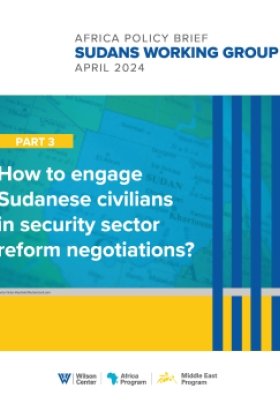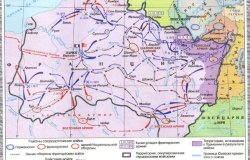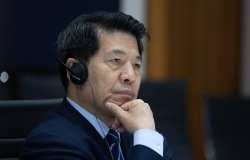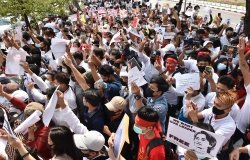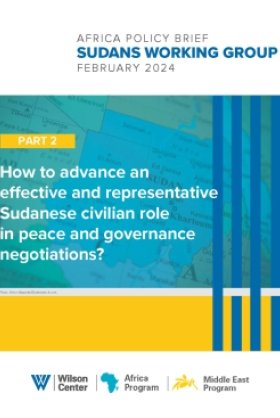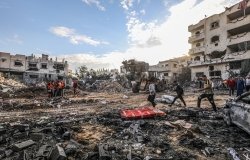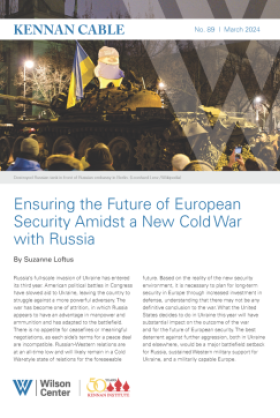The U.S. Role In The World: Enhancing The Capacity To Respond To Complex Contingency Operations
Ruth Wedgwood, professor of International Law at Yale and Johns Hopkins Universities; Ellen Laipson and Enid Schoettle the National Intelligence Council (NIC); Eric Schwartz, former National Security Council (NSC); Matthew McLean, NSC; Matthew Vaccaro, Defense Department; State Deptartment, Dennis Skocz; Robert Orr, Center for Strategic and International Studies; Julia Taft and Tapio Kanninen, United Nations, and others.
Overview
For a PDF file of the full conference proceedings click here.
The rising number of territorial 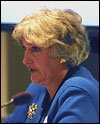 disputes, armed ethnic conflicts, and civil wars posing threats to regional and international peace are often accompanied by natural or manmade disasters resulting in widespread human suffering. Called complex contingency operations, the United States has responded to an increasing number since the end of the Cold War. The terrorist attacks of September 11 led many participants in the recent Wilson Center conference to reflect on what defines U.S. national security. Several suggested that we expand the definition of contingency operations, while others noted that the United States must remain engaged and combat terrorism on many fronts, not just militarily.
disputes, armed ethnic conflicts, and civil wars posing threats to regional and international peace are often accompanied by natural or manmade disasters resulting in widespread human suffering. Called complex contingency operations, the United States has responded to an increasing number since the end of the Cold War. The terrorist attacks of September 11 led many participants in the recent Wilson Center conference to reflect on what defines U.S. national security. Several suggested that we expand the definition of contingency operations, while others noted that the United States must remain engaged and combat terrorism on many fronts, not just militarily.
Complex contingency operations, such as Somalia, Bosnia, Rwanda, Haiti, Kosovo and East Timor, require better coordination between the U.S. military, U.S. agencies, coalition partners, international organizations, and NGOs, suggested the panelists. Speakers urged that any response effort aimed at stopping the downward spiral of violence, restoring stability, and promoting recovery requires meeting not only military demands, but political/diplomatic, humanitarian, intelligence, economic, social and security.
Panelists also explored the challenges of civil-military coordination during the operation and transition phases; enhancing the capacities of others to respond to complex contingency operations; and prospects for future operations.
Restoring Order in Complex Contingency Operations
Ruth Wedgwood, professor of International Law at Yale and Johns Hopkins Universities, summarized what she views as the chief weaknesses in U.S. capacity to restore order in a humanitarian emergency. These included a lack of infrastructure to reach remote areas, lack of a refugee strategy, inability to restore minimal security or deliver basic services, lack of willingness to confront corruption, and the inability to keep industry investment in the troubled area. Wedgwood also criticized the general outlook on relief operations, saying that we view them strictly as short-term, humanitarian crises as opposed to opportunities to build long term security and self-sufficiency.
Trends in Humanitarian Response
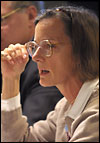 Ellen Laipson, vice chair of the National Intelligence Council (NIC), summarized a recent NIC report titled Global Trends 2015, which examined how the international system may be changing strategically over the next 10-15 years. This report outlined trends in the main drivers that shape international politics including demography, natural resources, science and technology, economics, governance, and cooperation and conflict.
Ellen Laipson, vice chair of the National Intelligence Council (NIC), summarized a recent NIC report titled Global Trends 2015, which examined how the international system may be changing strategically over the next 10-15 years. This report outlined trends in the main drivers that shape international politics including demography, natural resources, science and technology, economics, governance, and cooperation and conflict.
Enid Schoettle, also from NIC, outlined another pertinent and recent NIC study which examined several trends in current and emerging humanitarian disasters. This study assessed the global demand for money, food, and military intervention in response to humanitarian emergencies and their supply. According to the study, the primary cause of humanitarian disasters during the 90s was internal conflict. While the number of refugees is flat and may be heading down, the number of internally displaced people is rising. In terms of response, there continues to be a willingness from outside states to help as well as a local ability and desirability to help. Lastly, the demand for humanitarian assistance is likely to increase over the next 18 months.
U.S. Engagement in Complex Contingency Operations: Understanding the Tasks and Finding the Gaps and Seams
Eric Schwartz, former special assistant to the president and former senior director for multilateral and humanitarian affairs at the National Security Council (NSC), confirmed one of the trends reported by Shoettle--there is a large reservoir of support to overseas emergencies within the U.S. government. But, he stressed that we can only provide effective and efficient leadership if we are also prepared to address the political and secuity issues that are so often the proximate causes of humanitarian suffering.
According to Schwartz--and a message that would be repeated throughout the conference--effective response to emergencies requires coordinated action on political-military planning, peacekeepng, civilian administration, and humanitaria assistance. In response to this percieved need, the Clinton administration instituted Presidential Decision Directive 56: Where multiple agencies of the U.S. government are responding to a complex emergency or trying to anticipate a potential crisis, the government requires a plan that is integrated as well as a disciplined process to insure effective and coherent implementation. The Bush administration appears to be continuing this focus and work.
Integrating the Actors
Matthew McLean, director for planning and contingency operations for Democracy, Human Rights and International Operations at NSC talked about the next steps involved in interagency planning and coordination. He described the 4 components of contingency planning that are carried out by Policy Coordination Committees:
1. Warn. McLean looks to the intelligence agencies for their ability in painting scenarios.
2. Plan. The emphasis here is on strategic planning, not on operational planning. Concept papers help in the process.
3. Prevent. Now that we know the possible problems, how to prevent them? According to McLean, the U.S. should do more of this type planning with our regional counterparts.
4. Respond. Hopefully we have done some pre-thinking so we have some guidance. Pre-thinking and planning should eliminate the hand wringing stage.
Improving Civil-Military Coordination
Speaking from the military view, Matthew Vaccaro, Director for Peacekeeping at the Defense Department, thinks leadership is the most necessary, yet most difficult 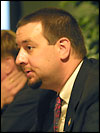 ingredient for achieving interagency planning. Leadership is necessary to prioritize advance thinking and planning. This is a tremendouse challenge, given that current operations always feel most urgent. Also, on the tangible, practical side, Vaccaro pointed out the need for an "interagency virtual place for political-military planning." Such technological innovation would enhance interagency cooperation, enabling collaboration across agency and across borders.
ingredient for achieving interagency planning. Leadership is necessary to prioritize advance thinking and planning. This is a tremendouse challenge, given that current operations always feel most urgent. Also, on the tangible, practical side, Vaccaro pointed out the need for an "interagency virtual place for political-military planning." Such technological innovation would enhance interagency cooperation, enabling collaboration across agency and across borders.
As the director of the Office of Contingency Planning and Peacekeeping at the State Deptartment, Dennis Skocz focused on the political in political-military (pol-mil) planning. He contrasted straight military planning with pol-mil planning, pointing out that military planning was at an operational level with heavy emphasis on logistics and command control, while pol-mil planning suggests a coordinated multi-agency effort on a strategic level where decisions are negotiated.
Julia Taft, former assistant secretary of State for Population, Refugess, and Migration, presented the NGO point of view of complex contingency operations. She desribed NGOs as "those on the ground, the first responders to any given situation," and therefore imbued with a unique perspective. The first responders to humanitarian disasters (health care professionals, fire brigades) are trained for rapid response. They are neutral and impartial. But according to Taft, this neutral environment often becomes threatened when the police arrive--often, a clash of cultures occurs. A successful intervention should be designed to harmonize these various roles. For example, she sees the military role as providing perimeter security, allowing relief workers access to do their job.
Engaging with the UN to Respond to Potential Conflicts
"The United Nations is trying to foster a culture of prevention," said Tapio Kanninen, Chief of the Policy Planning Unit in the UN's Department of Political Affairs. Although the Security Council is almost exclusively crisis and emergency driven, becoming involved only when violence has already occured, since the mid-1980s the Council has made efforts to raise conflict prevention higher on the agenda. A new phase was reached when the Council asked the Secretary General to prepare a comprehensive report on the prevention of conflict. A substantive resolution resulted in August 2001--the first of its kind. Some key ideas proposed in the report include periodic regional reporting on situations threatening international peace and security; establishment of an informal working group on prevention; and a systemwide approach and consistent funding for prevention.
Enhancing the Capacity of Others: Strengthening Regional Responses
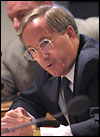 Experts from the regions of Latin America, Africa, East Timor, and Bosnia and Kosovo discussed recent regional crises and the success or failures of response. According to Len Hawley, former deputy assistant secretary of State and former director of multilateral affairs, National Security Council, a lead nation is the key to a successful multi-national complex contingency operation. The future problem he sees is that aside from the U.S., there are just 12 nations that possess the attributes to lead.
Experts from the regions of Latin America, Africa, East Timor, and Bosnia and Kosovo discussed recent regional crises and the success or failures of response. According to Len Hawley, former deputy assistant secretary of State and former director of multilateral affairs, National Security Council, a lead nation is the key to a successful multi-national complex contingency operation. The future problem he sees is that aside from the U.S., there are just 12 nations that possess the attributes to lead.
Responding to Complex Contingency Operations: Future Prospects
The final session looked at post-conflict reconstruction and the prospects for future operations. According to Robert Orr of the Center for Strategic and International Studies, post-conflict reconstruction must be looked at as a long-term process and therefore should be worked out in stages. Second, we need to keep the bulk of the burden of post-conflict reconstruction where it belongs--with the local people. Third, we need to engage a broad range of international actors, each with their own comparative advantage in certain skill areas.
Donald Daniel of NIC was tasked with writing an estimate on the future of peace operations. This report based on a meeting of mostly G-77 countries, distilled a number of both positive and negative factors for the future of peace operations. Among the positive factors was the willingness on the part of the international community to support peace operations; improvement in military capabilities in peacekeeping; and a greater number and better quality of peacekeeping training programs. Among the negative factors was the necessity of looking at peacekeeping holistically, as just one part of a larger effort which involves peacebuilding and civilian administration. According to Daniel, "If you are in for a dime, you are in for a dollar and if that is the case, some people don't want to be in for the dime."
Stove piped into Cold War structures, interagency coordination has been fraught with difficulties, including problems with information sharing, turf wars, competing agendas, and limited funding. A growing recognition that the U.S. must reorganize and adapt to the new security environment was further underscored by the tragedy of September 11. Out of the meeting arose some provocative suggestions for follow-on meetings: including one examining international cooperation and coordination; and another focusing on U.S. funding for contingency operations.
by Lauren Crowley
Documents & Downloads
- The U.S. Role In The World: Enhancing The Capacity To Respond To Complex Contingency OperationsDownload
- The U.S. Role In The World: Enhancing The Capacity To Respond To Complex Contingency OperationsDownload
- The U.S. Role In The World: Enhancing The Capacity To Respond To Complex Contingency OperationsDownload
Hosted By

Africa Program
The Africa Program works to address the most critical issues facing Africa and US-Africa relations, build mutually beneficial US-Africa relations, and enhance knowledge and understanding about Africa in the United States. The Program achieves its mission through in-depth research and analyses, public discussion, working groups, and briefings that bring together policymakers, practitioners, and subject matter experts to analyze and offer practical options for tackling key challenges in Africa and in US-Africa relations. Read more

Indo-Pacific Program
The Indo-Pacific Program promotes policy debate and intellectual discussions on US interests in the Asia-Pacific as well as political, economic, security, and social issues relating to the world’s most populous and economically dynamic region. Read more
Thank you for your interest in this event. Please send any feedback or questions to our Events staff.
